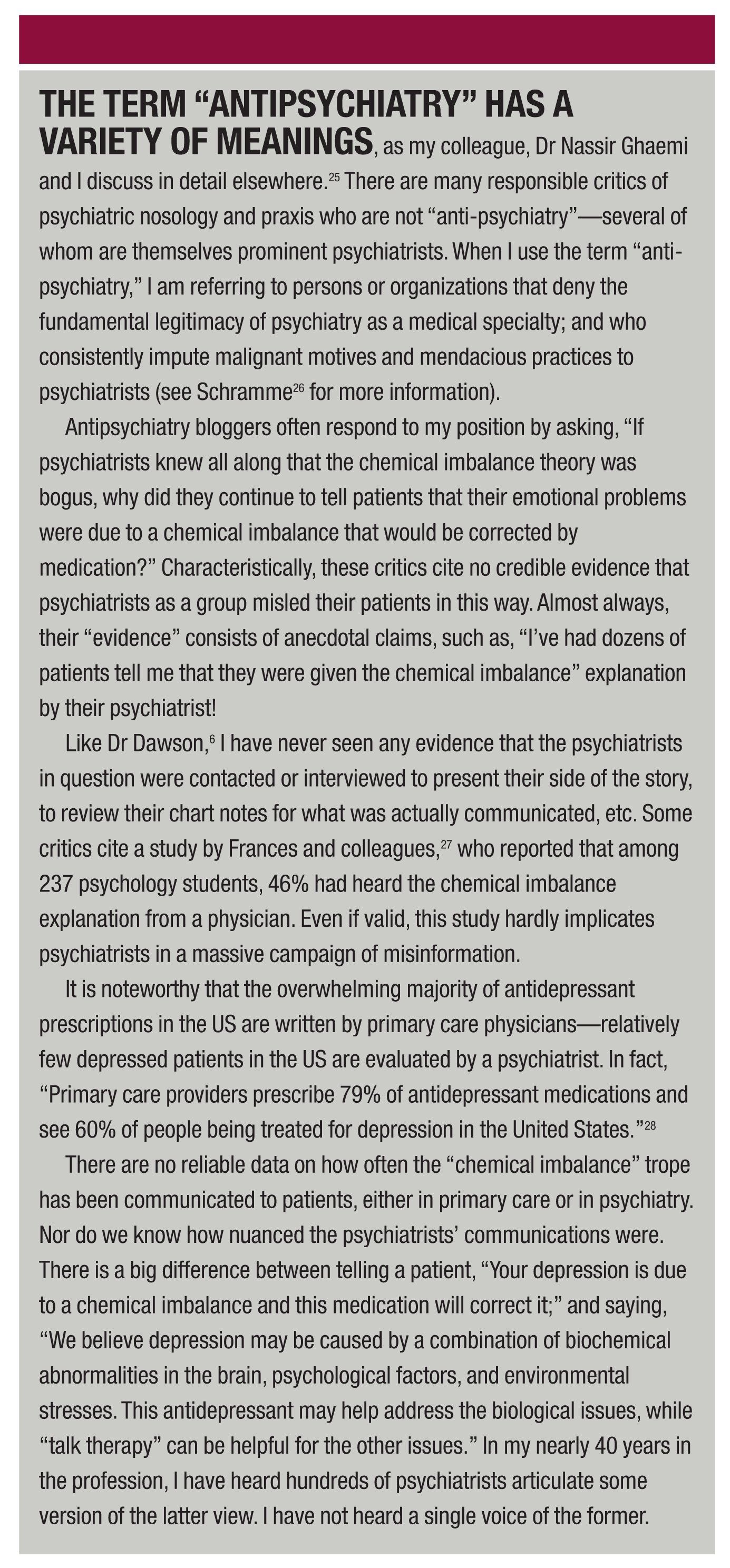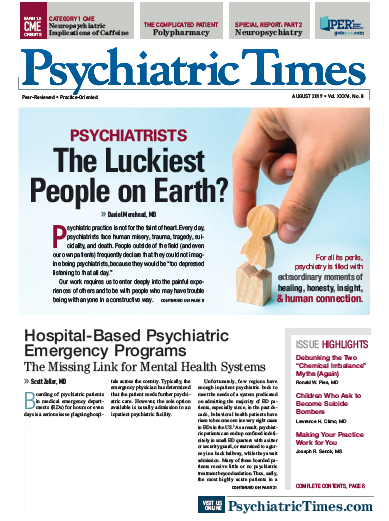Publication
Article
Psychiatric Times
Debunking the Two Chemical Imbalance Myths, Again
Author(s):
Moving toward a bio-psycho-sociocultural model of major depression.
©efks/AdobeStock

Sidebar

For reader feedback, see Chemical Imbalance? Readers Respond.
COMMENTARY
Dr Pies is Professor in the psychiatry departments of SUNY Upstate Medical University, Syracuse, NY and Tufts University School of Medicine, Boston. He is Editor in Chief Emeritus of Psychiatric Times (2007 to 2010).
A little learning is a dangerous thing.
- Alexander Pope1
Like the legendary Count Dracula, who could be killed only by driving a stake through his heart, some myths seem almost immortal. For more than 8 years now, I have tried to drive a stake through the heart of two myths regarding the so-called “chemical imbalance theory”-but with only limited success, as a recent piece in the New Yorker brought home to me.2-5
And, yes, there are really two myths to debunk. The first holds that mental illnesses (psychiatric disorders) in general are caused by “a chemical imbalance” in the brain-the so-called “chemical imbalance theory.” The second myth holds that “Psychiatry” as a profession endorsed the first myth, deliberately and knowingly lying to countless, unsuspecting patients. Depending on which anti-psychiatry group, blogger, or website you investigate, you will find a number of corollaries to the second myth; for example, “Psychiatrists lied to patients in order to justify giving them medication,” or “Psychiatrists were corrupted by Big Pharma, and stood to make a lot of money by promoting the chemical imbalance theory” (Sidebar). Rebuttals of these claims are almost always dismissed as, “Psychiatry defending its guild interests” (as if the purveyors of anti-psychiatry animus have no self-serving motives).
Ironically, anti-psychiatry groups are quite right in heaping scorn on the chemical imbalance theory of mental illness, but not for the reasons they usually give. (I hasten to add that debunking the chemical imbalance theory is not to deny that biological factors play an important role in serious mental illness, including but not limited to major depression, bipolar disorder, and schizophrenia). The fact is, there could never have been a scientifically based, chemical imbalance theory of mental illness, because a genuine theory requires an integrated network of well-supported, interlinked hypotheses. And yes, the frequently ignored distinction between a theory and a hypothesis is crucial. It is the key to understanding why claims by antipsychiatry bloggers regarding the chemical imbalance theory nearly always crash and burn.
The theory that never was
Scientifically speaking, there never was a network of validated hypotheses capable of sustaining a full-blown, global chemical imbalance theory of mental illness. Moreover-and here we come back to Myth 2-psychiatry as a profession and medical specialty never endorsed such a bogus “theory,” when judged by its professional organizations, its peer-reviewed publications, its standard textbooks, or its official pronouncements. Furthermore, the whole notion of some looming, monolithic “Psychiatry” is absurd on its face, as my colleague, George Dawson has argued.6
To be sure: what many psychiatrists in the 1980s and 1990s did promote was some version of the biogenic amine (or catecholamine) hypothesis of mood disorders, focusing mainly on the neurotransmitters norepinephrine and serotonin. (Schizophrenia was conventionally explained by the now outdated “dopamine hypothesis.”) And, in truth, the significance of serotonin was considerably over-emphasized-owing to what Roger S. McIntyre, MD has facetiously called, “Psychiatry’s High School Crush.”7
Furthermore, the SSRIs were accorded a rock-star status as effective antidepressants that they did not deserve. Most troubling from the standpoint of misleading the general public, pharmaceutical companies heavily promoted the “chemical imbalance” trope in their direct-to-consumer advertising. There was no concerted attempt by our profession to promote a causal or etiological theory of mental illness in general, based solely on chemical imbalances. Neither did the originators of the biogenic amine hypothesis-psychiatrists Joseph J. Schildkraut and Seymour S. Kety-promote such a view in the 1960s.8 Indeed, in 1965, Dr Schildkraut stated:
A rigorous extrapolation from pharmacological studies to pathophysiology clearly cannot be made. Clinical studies relevant to the catecholamine hypothesis are limited and the findings are inconclusive. It is not possible, therefore, to confirm definitively or to reject the catecholamine hypothesis on the basis of data currently available.
The closest thing we have to an “official” position on the etiology of psychiatric disorders is this 1978 statement from the American Psychiatric Association, which was approved by the APA Board of Trustees: “Psychiatric disorders result from the complex interaction of physical, psycho-logical, and social factors and treatment may be directed toward any or all three of these areas.”9
Critics of my thesis are inordinately fond of citing a dozen or so statements by various psychiatric luminaries-including two former APA presidents-that do, indeed, invoke the phrase, “chemical imbalance.” By cherry-picking quotes of this nature, anti-psychiatry groups and bloggers believe they have demonstrated that “Psychiatry” has defended a bogus chemical imbalance theory. These critics are simply wrong. Decontextualized quotes from a dozen-or even a hundred-famous psychiatrists do not represent an official professional consensus, much less the views of over 30,000 US psychiatrists.
Moreover, most of the quotes or statements usually cited by psychiatry’s critics use the term “chemical imbalance” in the specific context of antidepressants and their putative mechanism of action. For example, here is a quote from 2004:
Patients with neurotransmitter dysregulation may have an imbalance of serotonin and norepinephrine… Antidepressant medications that act as dual serotonin-norepinephrine reuptake inhibitors [SNRIs] . . . may aid in correcting the imbalance of serotonin and norepinephrine neurotransmission in the brain.10
The writer was hypothesizing a mechanism of action by which SNRIs may be helpful for patients who experience depression in the context of pain. He was certainly not propounding a causal chemical imbalance theory of depression, much less of psychiatric disorders in general. Note, as well, the careful use of the word “may.” Yes: with 20-20 hindsight, the imbalance claim has proved inaccurate and simplistic-but was not demonstrably false or mendacious when stated in 2004. (Even today, we simply do not have the sophisticated technology to verify or falsify, in real time, putative neurotransmitter “imbalances” in the human brain, during a patient’s depressive bout.) Indeed, with the benefit of further research, we now believe that the likely mechanisms of action of antidepressants are much more complicated than merely altering levels of neurotransmitters.
Psychiatrists questioned the chemical imbalance theory
By the early 2000s, psychiatrists were poking holes in the chemical imbalance trope and raising serious questions about the entire catecholamine hypothesis. Antipsychiatry critics should read over the chapter on mood disorders in The American Psychiatric Publishing Textbook of Clinical Psychiatry.11 In ten pages of text, the etiology of mood disorders is discussed in classic “bio-psycho-social” terms. No chemical imbalance theory is presented. As for the catecholamine hypothesis, “Additional experience has not confirmed the monoamine depletion hypothesis . . . [for example] depletion of serotonin can aggravate depression that has been in remission, but it does not predictably cause depression.”
And let’s be clear on another point: by whatever biological mechanisms, the clinical reality is that antidepressants are effective in many patients with severe, acute major depression.
The bio-psycho-sociocultural model
Far from asserting a chemical imbalance theory of mental illness, academic psychiatry-for at least the past 30 years-has advocated a bio-psycho-social (BPS) model of mental illness, as originally proposed by Dr George Engel.12,13 This position has been quite consistent. Furthermore, the most recent American Psychiatric Association’s formulation of depression states that several factors can play a role in depression, including biochemistry, genetics, personality, and environment.14
Within the biological component of the BPS model, new research is pointing to a variety of biological alterations in MDD and bipolar disorder that have little direct connection with chemical imbalances. For example, Miller and colleagues15 have summarized the data linking MDD with inflammation. Indeed, although still preliminary, there is evidence that some anti-inflammatory agents can improve antidepressant treatment effects.16 There is also growing evidence that various nerve growth factors, such as BDNF (brain-derived neurotrophic factor) are involved in the etiology of depression and the mechanism of action of some antidepressants.17 The rapid antidepressant effect of ketamine has also raised the possibility that the NMDA receptor, and possibly, the opioid system, are involved in the biology of depression.18
One important caveat, however: the DSM-5 construct of MDD is so broad and elastic, it almost certainly encompasses a multitude of underlying disease entities. As Dr Joel Paris has noted, “MDD is a highly heterogeneous category, leading to problems in classification and in specificity of treatment.”19
In the area of bipolar disorder, Maletic and Raison20 have described a “unified field theory” in which loss of brain volume in mood-regulating brain regions, dysregulation of glial-neuronal interaction, and abnormal hypothalamic-pituitary-adrenal function are interlinked with inflammatory activation. Such a sophisticated model cannot be reduced to chemical imbalances.
It is abundantly clear that biological factors are an important component of severe mood disorders. However, in recent years, psychiatrists have become increasingly interested in the environmental and sociocultural risk factors for depression. For example, the risk of postpartum depression is increased in the presence of a poor marital relationships, stressful life events, a negative attitude towards pregnancy, and lack of social support.21 A recent study has also shown that early life stress, such as childhood maltreatment, has a detrimental effect on brain structure, which increases the risk of an unfavorable disease course in major depression.22
Race and ethnicity are also possible risk factors for major depression. Bailey and colleagues23 report that “While minority populations are less likely to suffer from acute episodes of MDD than Caucasians, they are more likely to suffer from prolonged, chronic, and severely debilitating depression with heavy consequences on their level of daily functioning.”
Conclusion
In the 1980s, the 1990s, and beyond, pharmaceutical companies heavily promoted something resembling a chemical imbalance theory of mood disorders directly to consumers-or, at least, used the “chemical imbalance” trope to explain how antidepressants supposedly work. In recent years, as psychologist Dr John Grohol has pointed out, some non-professional websites have provided misleading graphics that reinforce the “chemical imbalance” trope.24 It is not surprising that the “Theory That Never Was” has taken hold in the minds of so many.
While some prominent psychiatrists have used the term “chemical imbalance” in their public comments about antidepressants-and possibly in their clinical practices (Sidebar)-there was never a unified, concerted effort within American psychiatry to promote a chemical imbalance theory of mental illness.
The original catecholamine hypothesis of mood disorders was carefully qualified by its originators in the 1960s, and has been recognized as significantly flawed and inadequate by US psychiatrists since at least 2003-and probably much earlier. The hypothesis has since been modified and corrected to reflect more complex biological mechanisms in major mood disorders. These disorders are best understood using a bio-psycho-sociocultural model, which has been the mainstay of academic psychiatry for over 30 years.
As with many other neuropsychiatric diseases, including Alzheimer disease, the precise causes of major mood disorders are still unknown. Almost certainly, there is a plethora of causal processes involved, depending on the diagnostic criteria and subtype of the illness (similar to the subtyping of anemia). Fortunately, we have effective pharmacologic and psychosocial treatments for mood disorders. As for the bogus chemical imbalance theory and its misattribution to the profession of psychiatry, it is time to drive the stake into its misbegotten heart. We must focus on providing our patients greater access to holistic, comprehensive psychiatric care.
Acknowledgement-My thanks to Dr George Dawson for commenting on an early draft of this essay.
This article was originally published on April 30, 2019 and has since been updated.
Disclosures:
The author reports no conflict of interest concerning the subject matter of this article.
References:
1. Pope A. A Little Learning. Poets’ Graves. https://www.poetsgraves.co.uk/Classic%20Poems/Pope/a_little_learning.htm. Accessed May 9, 2019.
2. Pies RW. Psychiatry’s new brain-mind and the legend of “chemical imbalance.” Psychiatric Times. July 11, 2011. http://www.psychiatrictimes.com/blogs/couch-crisis/psychiatry-new-brain-mind-and-legend-chemical-imbalance. Accessed April 30, 2019.
3. Pies RW. Doctor, is my mood disorder due to a chemical imbalance? PsychCentral.https://psychcentral.com/blog/archives/2011/08/04/doctor-is-my-mood-disorder-due-to-a-chemical-imbalance. Accessed April 30, 2019.
4. Pies RW. Nuances, narratives, and the “Chemical Imbalance” debate. Psychiatric Times. April 11, 2014. https://www.psychiatrictimes.com/couch-crisis/nuances-narratives-and-chemical-imbalance-debate. Accessed April 30, 2019.
5. Aviv R. The challenge of going off psychiatric drugs. The New Yorker. April 1, 2019. https://www.newyorker.com/magazine/2019/04/08/the-challenge-of-going-off-psychiatric-drugs. Accessed April 30, 2019.
[Note: I am quoted without context or source in this piece. The source of the quote is: http://psychcentral.com/blog/archives/2011/08/04/doctor-is-my-mood-disorder-due-to-a-chemical-imbalance]
6. Dawson G. The Myth of Monolithic Psychiatry. 2015. http://real-psychiatry.blogspot.com/2015/06/the-myth-of-monolithic-psychiatry.html. Accessed May 9, 2019.
7. Pies RW. Serotonin: How psychiatry got over its high school crush. Psychiatric Times. 2015;32(11): 28,35. https://www.psychiatrictimes.com/couch-crisis/serotonin-how-psychiatry-got-over-its-high-school-crush.
8. Schildkraut JJ. The catecholamine hypothesis of affective disorders: a review of supporting evidence.Am J Psychiatry. 1965;122:509-522.
9. American Psychiatric Association. Position statement on active treatment. Am J Psychiatry. 1979;136:753. http://www.psychiatry.org/File%20Library/Learn/Archives/Position-1978-Active-Treatment.pdf. Accessed April 30, 2019.
10. Trivedi MH. The link between depression and physical symptoms. Prim Care Companion J Clin Psychiatry. 2004;6(Suppl 1):12-16.
11. Dubovsky SL, Davies R, Dubovsky AN: Mood Disorders. In: Hales RE, Yudofsky SC. American Psychiatric Publishing Textbook of Clinical Psychiatry, 4th ed. Washington DC: American Psychiatric Publishing;2003.
12. Smith RC. The Biopsychosocial Revolution: Interviewing and Provider-patient Relationships Becoming Key Issues for Primary Care. J Gen Intern Med. 2002;17:309–310.
13. Pies RW. Comments on “cyclical swings” by Professor Hannah Decker: The underappreciated “solid center” of psychiatry. Hist Psychol. 2016;19:60-65.
14. American Psychiatric Association. What is depression? https://www.psychiatry.org/patients-families/depression/what-is-depression. May 9, 2019.
15. Miller AH, Maletic V, Raison CL. Inflammation and its discontents: the role of cytokines in the pathophysiology of major depression. Biol Psychiatry. 2009;65;732–741.
16. Köhler-Forsberg O, N Lydholm C, Hjorthøj C, et al. Efficacy of anti-inflammatory treatment on major depressive disorder or depressive symptoms: meta-analysis of clinical trials. Acta Psychiatr Scand. 2019;139:404-419.
17. Hashimoto K. Brain-derived neurotrophic factor as a biomarker for mood disorders: an historical overview and future directions. Psychiatry Clin Neurosci. 2010;64:341-357.
18. Williams NR, Heifets BD, Blasey C, et al. Attenuation of antidepressant effects of ketamine by opioid receptor antagonism. Am J Psychiatry. 2018;175:1205-1215.
19. Paris J. The mistreatment of major depressive disorder. Can J Psychiatry. 2014;59:148–151.
20. Maletic V, Raison C. Integrated neurobiology of bipolar disorder. Front Psychiatry. 2014;5:98.
21. Norhayati MN, Hazlina NH, Asrenee AR, et al. Magnitude and risk factors for postpartum symptoms: a literature review. J Affect Disord. 2015;175:34-52.
22. Opel N, Redlich R, Dohm K, et al. Mediation of the influence of childhood maltreatment on depression relapse by cortical structure: a 2-year longitudinal observational study. Lancet Psychiatry. 2019;6,318-26. https://www.thelancet.com/journals/lanpsy/article/PIIS2215-0366(19)30044-6/fulltext. Accessed April 30, 2019.
23. Bailey RK, Mokonogho J, Kumar A. Racial and ethnic differences in depression: current perspectives. Neuropsychiatr Dis Treat. 2019;15:603–609.
24. Grohol JM. The problem with Google’s health knowledge graphs. Psych Central. http://psychcentral.com/blog/archives/2015/08/21/the-problem-with-googles-health-knowledge-graphs. Accessed April 30, 2019.
25. Pies RW, Thommi S, Ghaemi SN. Getting it from both sides: foundational and antifoundational critiques of psychiatry. Psychiatric Times. July 2, 2011. https://www.psychiatrictimes.com/cultural-psychiatry/getting-it-both-sides-foundational-and-antifoundational-critiques-psychiatry. Accessed April 30, 2019.
26. Schramme T. The legacy of antipsychiatry. In: Schramme T, Thome J, eds. Philosophy and Psychiatry. Berlin: de Gruyter; 2004:94-119.
27. Frances CM, Lysaker PH, Robinson RP. The “chemical imbalance” explanation for depression: Origins, lay endorsement, and clinical implications. Prof Psychol Res Pr. 2007;38:411-420.
28. Barkil-Oteo A. Collaborative care for depression in primary care: how psychiatry could “troubleshoot” current treatments and practices. Yale J Biol Med. 2013;86:139–146.







